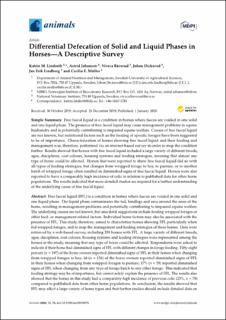| dc.description.abstract | Free faecal liquid (FFL) is a condition in horses where faeces are voided in one solid and one liquid phase. The liquid phase contaminates the tail, hindlegs and area around the anus of the horse, resulting in management problems and potentially contributing to impaired equine welfare. The underlying causes are not known, but anecdotal suggestions include feeding wrapped forages or other feed- or management-related factors. Individual horse factors may also be associated with the presence of FFL. This study, therefore, aimed to characterize horses showing FFL particularly when fed wrapped forages, and to map the management and feeding strategies of these horses. Data were retrieved by a web-based survey, including 339 horses with FFL. A large variety of different breeds, ages, disciplines, coat colours, housing systems and feeding strategies were represented among the horses in the study, meaning that any type of horse could be affected. Respondents were asked to indicate if their horse had diminished signs of FFL with different changes in forage feeding. Fifty-eight percent (n = 197) of the horse owners reported diminished signs of FFL in their horses when changing from wrapped forages to hay; 46 (n = 156) of the horse owners reported diminished signs of FFL in their horses when changing from wrapped forages to pasture; 17% (n = 58) reported diminished signs of FFL when changing from any type of forage batch to any other forage. This indicated that feeding strategy may be of importance, but cannot solely explain the presence of FFL. The results also showed that the horses in this study had a comparably high incidence of previous colic (23%, n = 78) compared to published data from other horse populations. In conclusion, the results showed that FFL may affect a large variety of horse types and that further studies should include detailed data on individual horse factors including gastrointestinal diseases as well as feeding strategies, in order to increase the chance of finding causes of FFL. | en_US |

